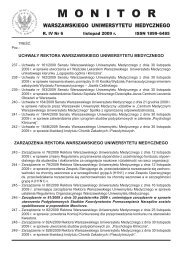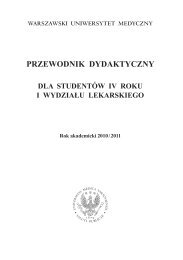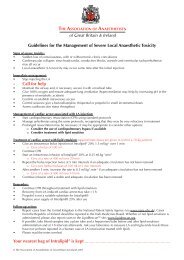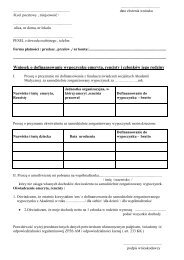ORAZ MOŻLIWOŚCI WYTWARZANIA W KULTURACH IN VITRO
Wersja pdf do pobrania - Biuletyn WydziaÅu Farmaceutycznego
Wersja pdf do pobrania - Biuletyn WydziaÅu Farmaceutycznego
Create successful ePaper yourself
Turn your PDF publications into a flip-book with our unique Google optimized e-Paper software.
O. Bołonkowska et al. /Biul. Wydz. Farm. WUM, 2011, 1, 1-27<br />
14. Asada Y., Li W., Yoshikawa T. (1998). Isoprenylated flavonoids from<br />
hairy root cultures of Glycyrrhiza glabra. Phytochemistry, 47(3):<br />
389-392<br />
15. Asamizu T., Abiyam K., Yasuda I. (1988). Anthraquinones production<br />
by hairy root culture in Cassia obtusifolia. Yakagaku Zasshi,<br />
108: 1215–1218<br />
16. Ayabe S., Iida K., Furuya T. (1986). Induction of stress metabolites<br />
in immobilized Glycyrrhiza echinata cultured cells. Plant Cell Reports,<br />
3: 186-189<br />
17. Banerjee S., Li Y., Wang Z., Sarkar F.H. (2008). Multi-targeted<br />
therapy of cancer by genistein. Cancer Letters, 269: 226–242<br />
18. Banthorpe D.V., White J.J. (1995). Novel anthraquinones from undifferentiated<br />
cell cultures of Galium verum. Phytochemistry,<br />
36(1): 107-111<br />
19. Barnard D.L., Huffman J.H., Morris J.L.B., Wood S.G., Hughes B.G.,<br />
Sidwell R.W. (1992). Evaluation of the antiviral activity of anthraquinones,<br />
anthrones and anthraquinone derivatives against human<br />
cytomegalovirus. Antiviral Research, 17: 63–77<br />
20. Barthe G.A., Jourdan P.S., Macintosh C.A., Mansell R.L. (1987). Naringin<br />
and limonin production in callus cultures and regenerated<br />
shoots from Citrus sp. Journal of Plant Physiology, 127: 55-65<br />
21. Bassetti L., Pijnenburg J., Tramper J. (1996). Silicone-stimulated<br />
anthraquinone production and release by Morinda citrifolia in a<br />
two-liquid-phase system. Biotechnology Letters, 18: 377–382<br />
22. Basu P., Chand S. (1996). Anthocyanin accumulation in Hyoscyamus<br />
muticus L. tissue cultures. Journal of Biotechnology, 52: 151-159<br />
23. Bel-Rhlid R., Chabot S., Piche Y., Chenevert T. (1993). Isolation<br />
and identification of flavanoids from Ri T-DNA transformed roots<br />
(Daucus carota) and their significance in vesicular–arbuscular Mycorrhiza.<br />
Phytochemistry, 35: 381–383<br />
24. Berglund T., Ohlsson A.B., Rydström J. (1993). Nicotinamide increases<br />
glutathione and anthocyanin in tissue culture of Catharanthus<br />
roseus. Journal of Plant Physiology, 141: 596–600<br />
25. Berlin J., Sieg S., Strack D., Bokern M., Harms H. (1986). Production<br />
of betalains by suspension cultures of Chenopodium rubrum L.<br />
Plant Cell, Tissue and Organ Culture, 5: 163–174<br />
26. Bhagyalakshmi N., Thimmaraju R., Narayan M.S. (2004). Various<br />
hexoses and di-hexoses differently influence growth, morphology<br />
and pigment synthesis in transformed root cultures of red beet (Beta<br />
vulgaris). Plant Cell, Tissue and Organ Culture, 78: 183–195<br />
27. Bhuiyan N.H., Adachi T. (2003). Stimulation of betacyanin synthesis<br />
through exogenous methyl jasmonate and other elicitors in suspension-cultured<br />
cells of Portulaca. Journal of Plant Physiology, 160:<br />
1117–1124<br />
28. Blando F., Scardino A.P., De Bellis L., Nicoletti I., Giovinazzo G.<br />
(2005). Characterization of in vitro anthocyanin-producing sour<br />
cherry (Prunus cerasus L.) callus cultures. Food Research International,<br />
38: 937–942<br />
29. Böhm H., Böhm L., Rink E. (1991). Establishment and characterization<br />
of a betaxanthin-producing cell culture from Portulaca grandiflora.<br />
Plant Cell, Tissue and Organ Culture, 26: 75–82<br />
30. Bokern M., Heuer S., Wray V., Witte L., Macek T., Vanek T., Strack<br />
D. (1991). Ferulic acid conjugates and betacyanins from cell cultures<br />
of Beta vulgaris. Phytochemistry, 30: 3261–3265<br />
31. Boltenkov E.V., Rybin V.G., Zarembo E.V. (2004). Specific features<br />
of cultivation of Iris ensata Thunb. callus tissue. Applied Biochemistry<br />
and Microbiology, 40(2): 206–212<br />
32. Boltenkov E.V., Rybin V.G., Zarembo E.V. (2005). Flavones from<br />
callus tissue of Iris ensata. Chemistry of Natural Compounds, 41(5):<br />
539-541<br />
33. Boyles M.J., Wrolstad R.E. (1993). Anthocyanin composition of red<br />
raspberry juice: influences of cultivar, processing, and environmental<br />
factors. Journal of Food Science, 58: 1135-1141<br />
34. Bridle P., Timberlake C.F. (1997). Anthocyanins as natural food colour-selected<br />
aspects. Food Chemistry, 58: 103-109<br />
35. Britton G. (1995). Structure and properties of carotenoids in relation<br />
function. Journal of the Federation of American Societies for<br />
Experimental Biology, 9: 1551– 1558<br />
36. Bulgakov V.P., Tchernoded G.K., Mischenko N.P., Khodakovskaya<br />
M.V., Glazunov V.P., Radchenko S.V., Zvereva E.V., Fedoreyev<br />
S.A., Zhuravlev Yu.N. (2002). Effect of salicylic acid, methyl jasmonate,<br />
ethephon and cantharidin on anthraquinone production by<br />
Rubia cordifolia callus cultures transformed with the rolB and rolC<br />
genes. Journal of Biotechnology, 97: 213–221<br />
37. Callebaut A., Terahara N., de Haan M., Decleire M. (1997). Stability<br />
of anthocyanin composition in Ajuga reptans callus and cell suspension<br />
cultures. Plant Cell, Tissue and Organ Culture, 50: 195–201<br />
38. Carew D.P., Krueger R.J. (1976). Anthocyanidins of Catharanthus<br />
roseus callus cultures. Phytochemistry, 15: 442<br />
39. Castańeda-Ovando A., Pacheco-Hernández M. de L., Páez-<br />
Hernández M.A., Rodríguez J.A., Galán-Vidal C.A. (2009). Chemical<br />
studies of anthocyanins: A review. Food Chemistry, 113: 859–871<br />
40. Castellar R., Obón J.M., Alacid M., Fernández-López J.A. (2003).<br />
Color properties and stability of betacyanins from Opunia fruits.<br />
Journal of Agricultural and Food Chemistry, 51: 2772–2776<br />
41. Chattopadhyay P., Chatterjee S., Sen S.K. (2008). Biotechnological<br />
potential of natural food grade biocolorants. African Journal of Biotechnology,<br />
7(17): 2972-2985<br />
42. Chen S., Wang X., Zhao B., Yuan X., Wang Y. (2003b). Production<br />
of crocin using Crocus sativus callus by two-stage culture system.<br />
Biotechnology Letters, 25: 1235–1238<br />
43. Chen S., Zhao B., Wang X., Yuan X., Wang Y. (2004). Promotion of<br />
the growth of Crocus sativus cells and the production of crocin by<br />
rare earth elements. Biotechnology Letters, 26: 27–30<br />
44. Chen X., Yang L., Hang N., Turbin J.A., Buckheit R.W., Sterling C.,<br />
Oppenheim J.J., Howard O.M.Z. (2003a). Shikonin, a component of<br />
Chinese herbat medicine, inhibits chemokine receptor function and<br />
suppresses Human Immunodeficiency Virus type 1. Antimicrobial<br />
Agents and Chemotherapy, 47(9): 2810-2816<br />
45. Chi Y.S., Jong H.G., Son K.H., Chang H.W., Kang S.S., Kim<br />
H.P.(2001). Effects of naturally occurring prenylated flavonoids on<br />
enzymes metabolizing arachidonic acid: cyclooxygenases and lipoxygenases.<br />
Biochemical Pharmacology, 62: 1185–1191<br />
46. Chong T.M., Abdullah M.A., Fadzillah N.M., Lai O.M., Lajis N.H.<br />
(2004). Anthraquinones production, hydrogen peroxide level and<br />
antioxidant vitamins in Morinda elliptica cell suspension cultures<br />
from intermediary and production medium strategies. Plant Cell<br />
Reports, 22: 951–958<br />
47. Chong T.M., Abdullah M.A., Lai O.M., Nor’Aini F.M., Lajis N.H.<br />
(2005). Effective elicitation factors in Morinda elliptica cell suspension<br />
culture. Process Biochemistry, 40: 3397–3405<br />
48. Chung B.Y., Lee Y.B., Baek M.H., Kim J.H., Wi S.G., Kim J.S.<br />
(2006). Effects of low-dose gamma-irradiation on production of shikonin<br />
derivatives in callus cultures of Lithospermum erythrorhizon<br />
S. Radiation Physics and Chemistry, 75: 1018-1023<br />
49. Clifford M.N. (2000). Anthocyanins – nature, occurrence and dietary<br />
burden. Journal of the Science of Food and Agriculture, 80(7):<br />
1063–1072<br />
50. Cota B.B., de Oliveira A.B. , Guimarães K.G., Mendonça M.P., de Souza<br />
Filho J.D., Braga F.C. (2004). Chemistry and antifungal activity of Xyris<br />
species (Xyridaceae): a new anthraquinone from Xyris pilosa. Biochemical<br />
Systematics and Ecology, 32: 391–397<br />
51. Côté F., Cormier F., Dufresne C., Willemot C. (2001). A highly specific<br />
glucosyltransferase is involved in the synthesis of crocetin glucosylesters<br />
in Crocus sativus cultured cells. Journal of Plant Physiology,<br />
15: 553–560<br />
52. Di Carlo G., Mascolo N., Izzo A.A., Capasso F. (1999). Flavonoids:<br />
old and new aspects of a class of natural therapeutic drugs. Life<br />
Science, 65 (4): 337-353<br />
53. Dias A.C.P., Tomás-Barberán F.A., Fernandes-Ferreira M., Ferreres<br />
F. (1998). Unusual flavonoids produced by callus of Hypericum perforatum.<br />
Phytochemistry, 48(7): 1165-1168<br />
54. Ding J., Shi S., Jiang B.-H., Yang Y.-H., Huang J., Shen H.-G., Xia<br />
K., Hang J., Jiang X. (2004). Effects of metyl jasmonate with indole-3-acetic<br />
acid and 6-benzylaminopurine on the secondary metabolism<br />
of cultured Onosma paniculatum cells. In Vitro Cellular &<br />
Developmental Biology-Plant, 40: 581-585<br />
55. Dörnenburg H., Knorr D. (1996). Semicontinuos process for anthraquinone<br />
production with immobilized Cruciata gabra cell cultures<br />
In a three-phase system. Journal of Biotechnology, 50: 55-62<br />
56. Dreiseitel A., Schreier P., Oehme A., Locher S., Rogler G., Piberger<br />
H., Hajak G., Sand P.G. (2008). Inhibition of proteasome activity by<br />
anthocyanins and anthocyanidins. Biochemical and Biophysical Research<br />
Communications, 372: 57–61<br />
57. Dufresne C., Cormier F., Dorion S., Niggli U.A., Pfister S., Pander<br />
H. (1999). Glycosylation of encapsulated crocetin by a Crocus sativus<br />
L. cell culture. Enzyme and Microbial Technology, 24: 453-462<br />
58. Endo M., Sakata K., Katayama A. (1997). The pigments in the callus<br />
of Rubia akane and their dyeing properties. Nippon Sanshigaku Zasshi,<br />
66: 107–112<br />
59. Fang Y., Smith M.A.L., Pépin M.F. (1998). Benzyl adenine restores<br />
anthocyanin pigmentation in suspension culturesof wild Vaccinium<br />
pahalae. Plant Cell, Tissue and Organ Culture, 54: 113–122<br />
60. Farag M.A., Hulman D.V., Lei Z., Sumer L.W. (2007). Metabolic profiling<br />
and systematic identification of flavonoids and isoflavonoids<br />
22

















